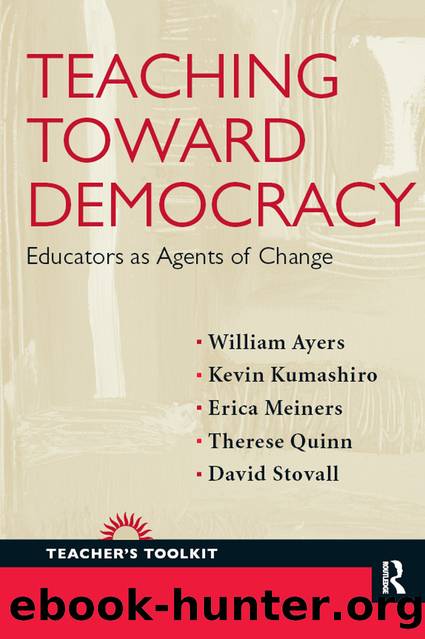Teaching Toward Democracy by Ayers William;Kumashiro Kevin;Meiners Erica;Quinn Therese;Stovall David;

Author:Ayers, William;Kumashiro, Kevin;Meiners, Erica;Quinn, Therese;Stovall, David;
Language: eng
Format: epub
ISBN: 4185998
Publisher: Taylor & Francis Group
GETTING OVER THE âWHAT TO DO NOWâ SYNDROME
The âwhat to do nowâ syndrome occurs when a teacher gets to the point where a curricular unit may have ended or a unit has finished earlier than planned, or he or she decided to go in another direction with the unit because it has flat-out bombed in its current state. When any of these scenarios happen, teachers often reach the age-old question: what am I going to do now?
This is especially important for social justice educators because your teaching will take on a life of its own, and your planning will be of a different type altogether. Instead of mapping entire units and assuming everything is set for the year, you will have to intentionally carve out time to develop your teaching while evaluating existing work and determining whether or not itâs relevant, whether or not it follows the interests and questions of students, and whether or not it connects to deeper and wider ways of knowing.
Social justice teaching is not some postmodern free-for-all, but it does have the potential to take off in numerous directions; it is therefore imperative that you take serious time to organize what you do as a teacher. Itâs important to plan, adjust, and develop your units, your curriculum, and your teaching. One effective way to promote your work as a social justice educator is to demonstrate that skills are indeed being learned through the content and approaches you have chosen to employ. This is not about standardization of social justice curriculum, but rather about focusing attention on how to create, critique, and revisit relevant spaces that will allow students to make informed decisions about their lives and seize an education worthy of a free people. This can also be done in a way that includes community, as in the case in Textbox 3.1.
TEXTBOX 3.1
A science teacher we know developed a unit on a coal-fired plant in the neighborhood where his school was located. Using an organization in the surrounding community as an anchor, he was able to collaborate to create a series of projects and assignments with the aim of engaging students in a real-life issue. Through this collaboration, he and the students discovered that there had been a community push to close the plant that dated back almost thirty years. The community where the plant is housed (the Little Village community in Chicago) has one of the highest rates of childhood asthma in the United States. Coal emissions are directly correlated with respiratory problems, and students were able to identify quite personally with the issue. As the unit progressed, students went through a number of experiments to demonstrate the harmful effects of particle ingestion over time. With the help of the partnering organization, the Little Village Environmental Justice Organization (LVEJO), students were able to learn about current efforts to address environmental justice issues in the community. In addition to the initiative to close the coal-fired plant, LVEJO was involved with other projects, including a push
Download
This site does not store any files on its server. We only index and link to content provided by other sites. Please contact the content providers to delete copyright contents if any and email us, we'll remove relevant links or contents immediately.
Chicken Soup for the Soul Presents Teens Talkin' Faith by Jack Canfield(647)
Understanding PDA Autism in Kids: A Guide for Parents and Teachers to Support Neurodiverse Learners by Jehu Len(554)
The Victorian Era: A Captivating Guide to the Life of Queen Victoria and an Era in the History of the United Kingdom Known for Its Hierarchy-Based Social Order by Captivating History(422)
Brain Teasers to Build Critical Thinking Skills by Safarova Kris(411)
Brain Teasers to Build Critical Thinking Skills: Brain Exercises for Tech, Banking, Case Interview Prep, and to Keep Your Mind Sharp by Kris Safarova(411)
100 Ideas for Secondary Teachers: Engaging Parents by Janet Goodall & Kathryn Weston(386)
Python 101 - Fundamentals by Sam(373)
Critical Curriculum Leadership : A Framework for Progressive Education by Rose M. Ylimaki(361)
Writing Solid Code: Development Philosophies for Writing Bug-Free Programs by Steve Maguire(356)
The Art of Emotional Validation: Improve Your Communication Skills and Transform Your Relationships by Validating Emotions and Feelings by Emily Wright(339)
Intersectionality in Educational Research by Dannielle Joy Davis; James L. Olive; Rachelle J. Brunn-Bevel; Susan R. Jones(331)
The Knights Templar: An Enthralling History of the Rise and Fall of the Most Influential Catholic Military Order by Wellman Billy(329)
A Beginner's Guide to SSD Firmware by Unknown(327)
The Future Knowledge Compendium by Ellyard Peter;(319)
How to be assertive in any situation by Hadfield Sue & Hasson Gill(310)
Making Connections in and Through Arts-Based Educational Research by Hala Mreiwed Mindy R. Carter Sara Hashem Candace H. Blake-Amarante(305)
Foundations of Educational Research by Victoria Elliott(305)
What Every Teacher Should Know about Learning, Memory, and the Brain by Tileston Donna E. Walker;(305)
Message from the Pleiades; The Contact Notes of Eduard Billy Meier v1 only by unknow(301)
